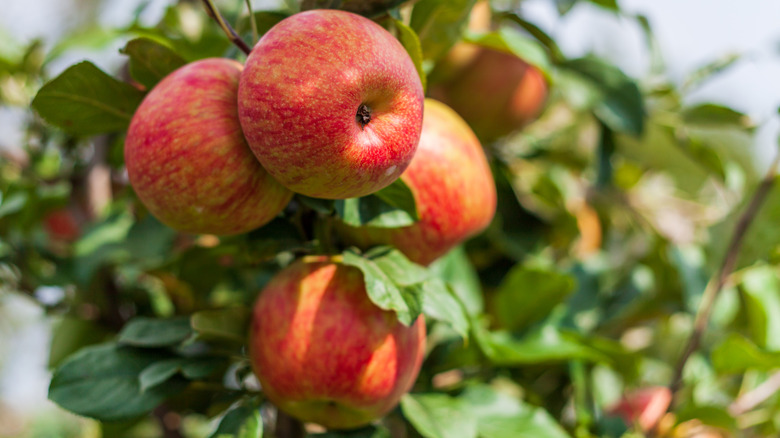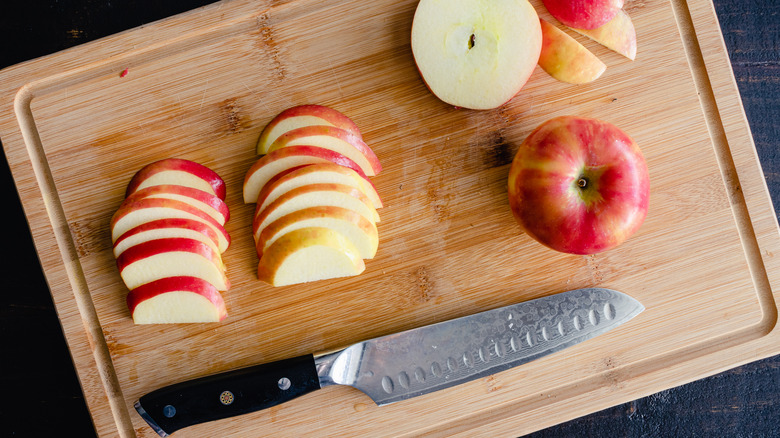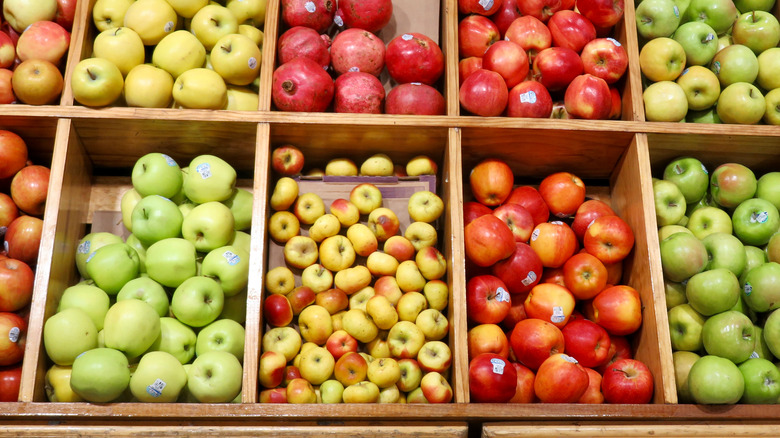The Honeycrisp Apple Is More Modern Than You Might Expect
For a lot of people, Honeycrisp tastes like the ideal apple. Balanced between tart and sweet with a signature satisfying crunch, it seems like an apple that should have always existed, perfectly shaped by nature to be plucked off a tree by some passing nomadic human for a refreshing, nourishing treat. But the reality is far from that. Just like many of the staggering 2,500 varieties of apples grown in the U.S., it was born from human intervention, its distinct qualities chosen and meticulously cultivated (via Food & Wine).
It wasn't that long ago that there were only three types of apples widely available across the country: McIntosh, Red Delicious, and Golden Delicious. The advent of easy refrigerated shipping in the early 20th century turned apples from a local product into a national commodity, and both growers and sellers adapted to the new reality (via The New Yorker). Apples were bred for durability and long shelf life but not for taste. This led to the domination of those three big supermarket staples. That is the apple world most people growing up in the 1970s or 1980s remember, and the market Honeycrisp was created to disrupt.
Honeycrisp apples are a child of the 90s
Per the United States Department of Agriculture (USDA), the Honeycrisp apple was born at the University of Minnesota after decades of crossbreeding before being released to the public in 1991. According to Orange Pippen, the development of Honeycrisp was long and complex enough that the apples it was bred from needed to be rediscovered by a DNA test. Even then, the result showed one of its parents was an unnamed apple variety that has since been lost. All that work paid off though, as Vox explains that the Honeycrisp's excellent snap is a result of breeding it to have larger cells, which burst with juices when ruptured. It's a true feat of modern science and human determination that changed the apple market forever.
Despite its fantastic qualities as an apple, Honeycrisp was not an instant success. It took years before the larger public started regularly seeing it. Food & Wine notes that it is more delicate and expensive to cultivate than the tough, mass-produced apples like Red Delicious, which made the industry hesitant to adopt Honeycrisp. However, in the end, taste won out, as customers proved willing to pay a premium for an apple that was so much better than the less flavorful varieties they were used to. By the late 2010s, Honeycrisps were the fifth most popular apple in America, and other new apple varieties were piggybacking on its success.
Will Honeycrisp be surpassed?
The same forces that led to the birth of the Honeycrisp in 1991 could also be its downfall as the industry moves forward. According to Wired, Honeycrisps could be the victim of its own popularity, as it set off a wave of new apple breeding in a rush to replicate its success. Just like how old commercial apples had issues with taste and texture, the Honeycrisp has an issue with durability as its flesh bruises very easily. Additionally, the same costs that made growers hesitant to adopt it are why they may now be looking to replace it. As more are grown, Honeycrisps could also sit on the shelf longer, succumbing to the same decline in quality that affected apples like Red Delicious.
Just in the last few years new varieties of apples like Ambrosia and Cosmic Crisp have come to the market, each following in the sweet, snappy footsteps of Honeycrisp. Even the University of Minnesota has been trying to displace its own signature creation, breeding, and releasing the SweeTango, which is essentially a Honeycrisp 2.0 (via the University of Minnesota). As apple innovation continues at a breakneck pace, it's not hard to imagine a world where some a varietal that has even been created yet is as ubiquitous and loved 20 years from now as Honeycrisp is today, while the original has faded to obscurity.


